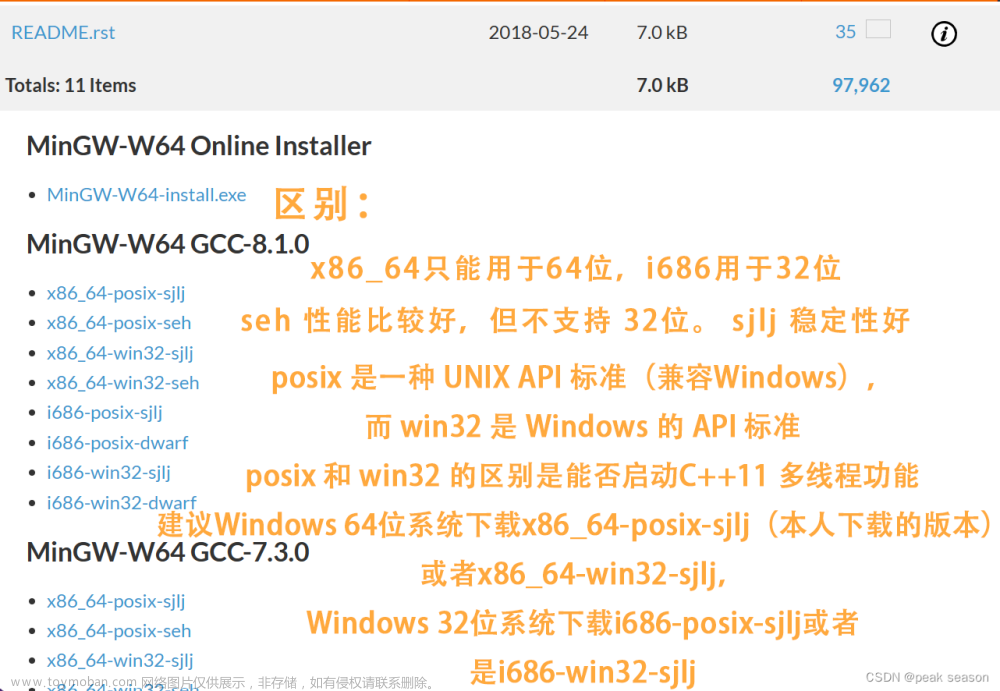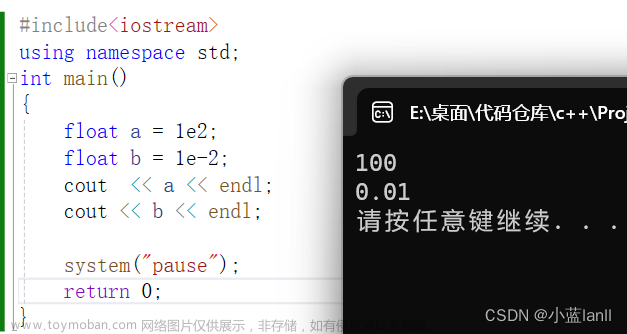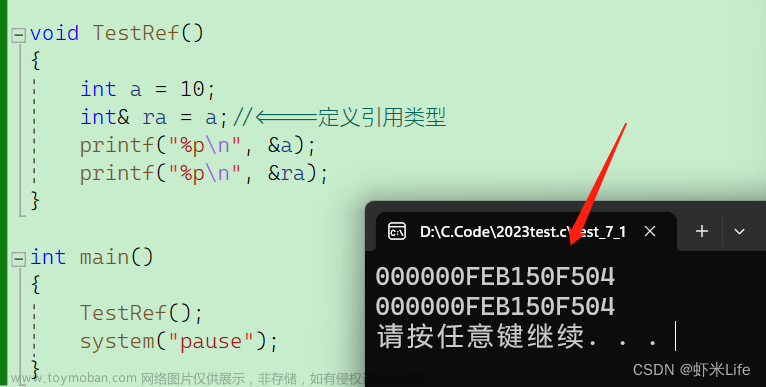目录
对齐方式
‘stream’流文件读写
文件操作
- 流系体系
- 流:数据从一个对象到另一个对象的传输。
- 功能:标准输入输出+文件处理
分类 含义 文本流 一串ASCII子符 二进制流 一串二进制
- ‘ios’是抽象类
- ‘ostream’是‘cout’、‘clog’、‘cerr’的类
- ‘istream’是‘cin’的类
全局流变量 名称 缓存 ‘cout’ 标准输出流 带缓存 ‘cin’ 标准输入流 带缓存 ‘clog’标准日志流 带缓存 ‘cerr’ 标准错误流 无缓存 - 输出流默认设置
类型 进制 宽度 对齐 填充 精度 整数 十进制 0 右对齐 空格 1 实数 十进制 0 右对齐 空格 6位数 字符串 - 0 右对齐 空格 字符串实际长度
-
格式控制
-
格式控制成员函数
流对象.格式控制成员函数(实参)- 1
-
预定义格式控制函数
预定义格式控制函数(实参)- 1
-
-
流的输出控制格式
| 进制 | ‘flags()’、‘setf()’、‘unsetf()’ | ‘setiosflags()’ | ‘dec’、‘oct’、‘hex’、‘showbase’ | 能继续使用 |
| 宽度 | ‘width(n)’ | ‘setw(n)’ | - | 不能连续 |
| 对齐 | ‘flags()’、‘setf()’、‘unsetf’ | ‘setiosflags()’ | ‘right’、‘left’、‘internal’ | 能连续使用 |
| 填充 | ‘fill(c)’ | ‘setfill(c)’ | - | 能连续使用 |
- 流的输出控制格式:‘dec’、‘oct’、‘hex’
- 数据输入成员函数
- 子符输入成员函数:‘get()’
- 子符串输入成员函数:‘getline()’
- 数据输出成员函数:‘put() ’
对齐方式
flag manipulator 作用 ‘ios::left’ ‘left’ 居左 ‘ios::right’ ‘right’ 居右 ‘ios::internal’ ‘internal’ 输出符号或进制后填充
#include <iostream>
using namespace std;
int main(){
int n = -11;
cout.width(6);
cout.flags(ios::right);
cout << n << endl;
cout.width(6);
cout.flags(ios::left);
cout << n << endl;
cout.width(6);
cout.flags(ios::internal);
cout << n << endl;
}
#include <iostream>
#include <iomanip>
using namespace std;
int main(){
int n = -11;
cout << setw(6) << right << n << endl;
cout << setw(6) << left << n << endl;
cout << setw(6) << internal << n << endl;
}
#include <iostream>
using namespace std;
int main(){
int n = -11;
cout.width(6); cout << left << n << endl;
cout.width(6); cout << right << n << endl;
cout.width(6); cout << internal << n << endl;
}
整数输出格式
| flag | manipulator | 作用 | 是否默认 |
|---|---|---|---|
ios::dec |
dec |
十进制 | 是 |
ios::oct |
oct |
八进制 | 否 |
ios::hex |
hex |
十六进制 | 否 |
ios::uppercase |
uppercase |
使用大写输出十六进制 | 否 |
ios::showbase |
showbase |
输出带有进制的字符 | 否 |
#include <iostream>
using namespace std;
int main(){
int n = 11;
cout.flags(ios::dec);
cout << n << endl;
cout.flags(ios::hex);
cout << n << endl;
cout.flags(ios::oct);
cout << n << endl;
cout.flags(ios::showbase|ios::dec);
cout << n << endl;
cout.flags(ios::showbase|ios::oct);
cout << n << endl;
cout.flags(ios::showbase|ios::hex);
cout << n << endl;
cout.flags(ios::showbase|ios::uppercase|ios::dec);
cout << n << endl;
cout.flags(ios::showbase|ios::uppercase|ios::oct);
cout << n << endl;
cout.flags(ios::showbase|ios::uppercase|ios::hex);
cout << n << endl;
}
#include <iostream>
using namespace std;
int main(){
int n = 11;
cout << dec << n << endl;
cout << hex << n << endl;
cout << oct << n << endl;
cout << showbase << dec << n << endl;
cout << oct << n << endl;
cout << hex << n << endl;
cout << uppercase << dec << n << endl;
cout << oct << n << endl;
cout << hex << n << endl;
}
浮点数八进制/十六进制不能输出结果。
| flag | 作用 | 是否默认 |
|---|---|---|
| ‘ios::showpoint’ | 输出浮点数时,必须带小数点 | 否 |
- 浮点数输出格式
flag 作用 是否默认 ‘ios::scientific’ 科学计数法输出浮点数 否 ‘ios::fixed’ 定点数方式输出实数 是
定点数方式比浮点数方式更精确
取浮点数精确度时,设置‘ios::fixed’
#include <iostream> // cout, std::fixed, std::scientific
using namespace std;
int main () {
double a = 3.1415926534;
double b = 2006.0;
double c = 1.0e-10;
cout.precision(5);
cout << "default:\n";
cout << a << endl << b << endl << c << endl;
cout << "fixed:\n";
cout.flags(ios::fixed);
cout << a << endl << b << endl << c << endl;
cout << "scientific:\n";
cout.flags(ios::scientific);
cout << a << endl << b << endl << c << endl;
return 0;
}
#include <iostream> // std::cout, std::fixed, std::scientific
#include <iomanip>
using namespace std;
int main () {
double a = 3.1415926534;
double b = 2006.0;
double c = 1.0e-10;
cout << setprecision(5)
<< "default:\n"
<< a << endl << b << endl << c << endl;
cout << "fixed:\n" << fixed
<< a << endl << b << endl << c << endl;
cout << "scientific:\n" << scientific
<< a << endl << b << endl << c << endl;
return 0;
}
#include <iostream> // std::cout, std::fixed, std::scientific
int main () {
double a = 3.1415926534;
double b = 2006.0;
double c = 1.0e-10;
std::cout.precision(5);
std::cout << "default:\n";
std::cout << a << '\n' << b << '\n' << c << '\n\n'
std::cout << "fixed:\n" << std::fixed;
std::cout << a << '\n' << b << '\n' << c << '\n\n'
std::cout << "scientific:\n" << std::scientific;
std::cout << a << '\n' << b << '\n' << c << '\n\n';
return 0;
}
- 布尔类型输出格式
| flag | manipulator | 作用 |
|---|---|---|
| ‘ios::boolapha’ | ‘boolalpha’ | 把‘bool’值以字符串‘true’/‘false’输出 |
- 正数或十进制‘0’带‘+’
| flag | manipulator | 作用 |
|---|---|---|
| ‘ios::showpos’ | ‘showpos’ | 输出十进制0或者正数时,带‘+’ |
#include <iostream> // std::cout, std::showpos, std::noshowpos
using namespace std;
int main () {
int p = 1;
int z = 0;
int n = -1;
cout << showpos << p << '\t' << z << '\t' << n << endl;
cout << noshowpos << p << '\t' << z << '\t' << n << endl;
return 0;
}
#include <iostream> // std::cout, std::showpos, std::noshowpos
using namespace std;
int main () {
int p = 1;
int z = 0;
int n = -1;
cout.setf(ios::showpos); cout << p << '\t' << z << '\t' << n << endl;
cout.unsetf(ios::showpos); cout << p << '\t' << z << '\t' << n << endl;
return 0;
}
字符串转化数字
istringstream iss(str);
int n;
iss >> n;C++11提供如下函数简化字符串转函数
- ‘stoi()’、‘stol()’、‘stoul’、‘stoll’、‘stoull()’、‘stof()’、‘stod()’、‘stold()’
数字转化字符串
int n;
ostringstream oss;
oss << n;
oss.str();‘string’字符串遍历
string str("abcdefg");1 .C写法
for(size_t i = 0; i < str.size(); i++)
{
cout << str[i] << endl;
}2 .迭代器写法
for(string::iterator it = str.begin(); it != str.end();it++)
{
cout << str[i] << endl;
}3 .STL ‘for_each’写法
void print(char c){
cout << c << endl;
}
for_each(str.begin(),str.end(),print);4 .C++11迭代器写法
for(string::iterator it = begin(str);it != end(str); it++){
cout<< *it << endl;
}或者
for(auto it = begin(str);it!=end(str);it++){
cout<<*it<<endl;
}5 .C++11 for新语法写法
for(char c : str){
cout<<c<<endl;
}或者
for(auto c : str){
cout << c << endl;
}6 .C++11 STL ‘for_each’与lamdba表达式
for_each(begin(str),end(str),[](char c){cout << c <<endl;});向量遍历
vector<int> vec;
vec.push_back(1);
vec.push_back(2);
vec.push_back(3);
vec.push_back(4);
vec.push_back(5);1 .C写法
for(size_t i = 0; i < vec.size(); i++){
cout << vec[i] << endl;
}2 .迭代器写法
for(vector<int>::iterator it = vec.begin(); it != vec.end();it++){
cout<<*it<<endl;
}3 .STL ‘for_each’写法
void print(int n){
cout<< n << endl;
}
for_each(vec.begin(),vec.end(),print);4 .C++迭代器写法
for(vector<int>::iterator it = begin(vec);it != end(vec);it++){
cout << *it <<endl;
}或者
for(auto it = begin(vec); it != end(vec);it++){
cout<<*it<<endl;
}5 .C++11 for新语法
for(int n : vec){
cout << n << endl;
}或者
for(auto n : vec){
cout << n << endl;
}6 . C++11 STL ‘for_each’与lamdba表达式
for_each(begin(vec),end(vec),[](int n){cout << n <<endl;});C++文件读写
文件:文件名+文件内容(有序数据集合)
文件名:子符序列
文件数据格式:二进制文件/文本文件
- C++文件操作流程
- 打开文件
- 读写文件
- 关闭文件
- 打开/关闭文件
操作 代码 定义读文件流对象 ‘ifstream读文件流对象’ 定义写文件流对象 ‘ofstream写文件流对象’ 定义读写文件流对象 ‘fstream读写文件流对象’ 成员函数打开文件 ‘文本流对象.open(文件名,文件打开方式)’ 构造函数打开方式 ‘文件流类 对象(文件名,文件打开方式)’ 判断文件是否打开 ‘!文件流对象’ 关闭文件 ‘文件流对象.close(变量)’
文本文件读写
| 操作 | 代码 |
|---|---|
| 提取运算符读文件 | ‘文件流对象 >> 变量’ |
| 插入运算符写文件 | ‘文件流对象 << 变量’ |
| 成员函数读文件 | ‘文件流对象.get(变量)’ |
| 成员函数写文件 | ‘文件流对象.put(变量)’ |
二进制文件读写
| 操作 | 代码 |
|---|---|
| 读函数 | ‘read()’ |
| 写函数 | ‘write()’ |
| 测试文件结束 | ‘eof()’ |
文件打开方式
| 类型 | 代码 |
|---|---|
| 读 | ‘ios::in’ |
| 写 | ‘ios::out’ |
| 添加末尾 | ‘ios::app’ |
| 已存在文件 | ‘ios::nocreate’ |
| 未打开文件 | ‘ios::noreplace’ |
| 二进制 | ‘ios::binary’ |
* 文件对象指针位置函数
| 类型 | 代码 |
|---|---|
| 读 | ‘ios::in’ |
| 写 | ‘ios::out’ |
| 添加至行尾 | ‘ios::app’ |
| 已存在文件 | ‘ios::nocreate’ |
| 如果文件不存在则建立新文件,如果文件以存在则操作失败 | ‘ios::noreplace’ |
| 二进制 | ‘ios::binary’ |
文件对象指针位置函数
| 操作 | 代码 |
|---|---|
| 获取读位置 | ‘对象.tellg()’ |
| 获取写位置 | ‘对象.tallp()’ |
| 设置读位置 | ‘对象.seekg()’ |
| 设置写位置 | ‘对象.seekp()’ |
如果文件是以‘ios::app’文本追加方式打开,指针位置默认在文件结束,其他情况默认在文件开头。
文件对象状态符
| 操作 | 代码 |
|---|---|
| 判断文件对象状态是否正常 | ‘对象.good()’ |
| 重置文件对象状态 | ‘对象.clear()’ |
流式文件类型
1. ‘stream’流文件
2. 文件指针‘FILE*’
‘stream’流文件读写
ofstream fout(文件路径);
fin >> 变量;
fout.close();- ‘ifstream’文件读
-
ifstream fin(文件路径); fin >> 变量; fin.close(); - ‘ofstream’文件写
‘fstream’文件–先写后读
fstream fs(文件路径);
if(fs){
fs << 变量;
fs.seekp(ios::beg);
fs >> 变量;
fs.close();
}- ‘fstream’文件–先读后写
fstream fs(文件路径)
if(!fs){
fs >> 变量;
fs.clear();
fs << 变量;
}文件指针‘FILE’读写
- ‘FILE’文件指针读
FILE* fp = fopen(文件路径,"r");
fscanf( "hello", fp);
fclose(fp);对象的序列化与反序列化
序列化:把对象转化成文本/二进制
反序列化:把文本/二进制转化成对象
文件重定向
freopen(文件路径,操作,标准IO);操作:读(‘w’) 写(‘r’)
- 重定向写
freopen("out.txt","w",stdout);
cout << "out data" <<endl;- 重定向读
freopen("in.txt","r",stdin);
string str;
cin >> str;几种常见的文件读取方式对比(效率自上而下,第一个效率最高)
1. ‘ifstream’ + ‘fin’
2. ‘freopen’ + ‘cin’ + ‘sync_with_stdio(false)’
3. ‘FILE* ’ + ‘fscanf’
4. ‘freopen’ + ‘scanf’
5. ‘freopen’ + ‘cin’ 文章来源:https://www.toymoban.com/news/detail-424147.html
文章来源地址https://www.toymoban.com/news/detail-424147.html
到了这里,关于C++语言基础——文件的文章就介绍完了。如果您还想了解更多内容,请在右上角搜索TOY模板网以前的文章或继续浏览下面的相关文章,希望大家以后多多支持TOY模板网!

![【C++ 进阶】第 1 章:[C 语言基础] C 语言概述与数据类型](https://imgs.yssmx.com/Uploads/2024/02/615384-1.png)









